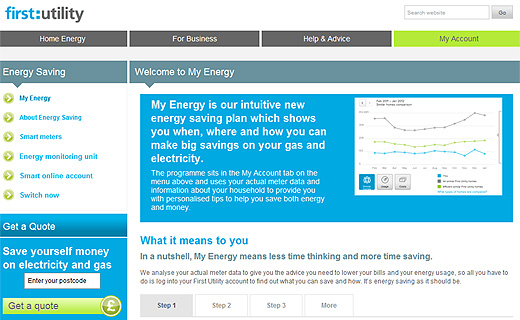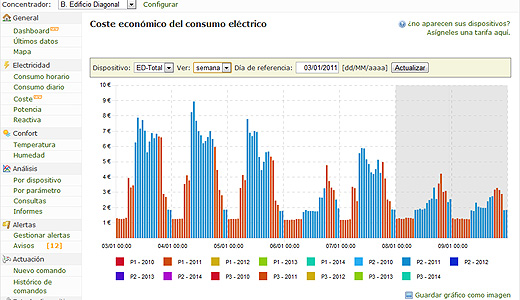
The home of the future might still be a retrofuturist’s dream but there are tools available today that are starting to help us toward a smart home, even if we don’t have a spaceport outside like the Jetsons.
Home energy monitoring might not sound like the sexiest proposition for a futuristic pad, but it’s a practical start and it’s not really as hard as you might think.
Last month we took a look at AlertMe, the smart home technology company that has partnered with British Gas. The pairing means that traditional gas meters can be replaced with smart meters that can share a lot more information.
Your energy consumption can be compared with other similar homes and you can then work out ways to lower this and save some money along the way.
There are of course other options. Just last week, First Utility, a UK independent energy supplier launched my:energy. This system also compares energy usage with neighbours and provides ideas for saving that energy.
It also provides more information securely on its website for First Utility customers and over the next few months it will roll out further functionality.
This will include unusual usage alerts which can email or send an SMS to customers as well as text message reminders to let people know when to turn down their thermostats when warmer weather is forecast.

First Utility has partnered with Opower, the energy information software provider and according to them, my:energy has the potential to save UK households £1.7 billion and 3 million tonnes of carbon over a three-year period. That’s not a bad start for trying to make an environmental difference.
Of course if you’re in the US, you could install a Nest learning thermostat, but when energy suppliers are offering a helping hand, simple monitoring could be an easy way in to learning more about this kind of data around the home.
Not as tricky as you think
Though this technology is fairly new, it has been possible for a little while already but uptake seems slow unless energy suppliers get involved. So what’s the hold up?
Terry Gray is a UK-based electrical engineer who has been working in the trade for more than 40 years. As an independent source he answered a few questions about this kind of monitoring.
Gray feels that it’s about time we started monitoring energy consumption as this will help us cope should we reach a critical point where we can no longer take things for granted.
Monitoring energy is not a fiddly or complicated thing to do either. Gray says, “Adding a clip around cables that bring electricity into the home is a simple way to keep an eye on consumption. The magnetic field around an electricity cable is monitored and that is then translated to let you know how much you are using. It’s not dangerous and you don’t touch any live wires”.
There’s no excuse if you live in some crazily wired country pile either. Gray says that it doesn’t matter if you live in an old place or a new build as the process of clipping on a monitor is the same.
One thing that he has seen changing is the skill set required by electrical engineers. It’s a hopeful move that these professionals are now adding energy efficiency to their accreditation.
Gray feels that there should be more use of renewable energies. He notes that our love for gadgets, computing and electrical goods means that we are consuming a lot more and there are few ways in which we can cope for the long-term at this level.
Gray’s advice was to be proactive and learn a little more for yourself, he pointed to the NICEIC, the independent voluntary body for the electrical industry in the UK as a good resource for finding some good advice.

Business responsibilities
Energy at home is something we can feel a bit better about once we start to look at what we are doing and note changes if we do simple things like turning down heating, turning gadgets off instead of into standby mode and switching off the lights.
Businesses can also save a lot of money by monitoring their consumption. Xavier Orduña is the founder and CTO of Dexma Technologies [SP] in Barcelona. If you are starting a business in a new location, every penny counts for overheads, so it’s worth considering ways in which you can save some money on the way.
Dexma provides monitoring for businesses in buildings. Orduña says, “You can change the technology you use by setting hours or levels of consumption, but it’s also important to remind employees to do things like switch the lights off.”
“When no one is watching, people waste energy,” he points out. “When managers have information about the cost of energy consumption, they can train their staff to use things like air conditioning in a more efficient way. When people know that someone is watching, they will change their behaviour.”

Monitoring energy for businesses also requires a lot more sensors and a higher frequency of monitoring to be effective. Orduña says that domestic monitors are easier to use and install but that the margin of error is smaller for professional systems. The installation methods are much the same.
In a home setting, Orduña points out that energy monitoring also works as a way to ensure you can understand changes in the home. If you use energy-efficient light bulbs, or insulate your windows, you’re probably making the right decision, but if you put a monitor in first, you can make a comparison that really shows the difference.
A link between consumption and behaviour can make changes. Though we all probably know we could be doing more, it’s a good habit that is easy to break. Hopefully having some hard data to consider and spot the results we can find ways to inspire us to save a bit more energy with new technologies.
Get the TNW newsletter
Get the most important tech news in your inbox each week.





